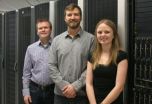(Press-News.org) From super-lubricants, to solar cells, to the fledgling technology of valleytronics, there is much to be excited about with the discovery of a unique new two-dimensional semiconductor, rhenium disulfide, by researchers at Berkeley Lab's Molecular Foundry. Rhenium disulfide, unlike molybdenum disulfide and other dichalcogenides, behaves electronically as if it were a 2D monolayer even as a 3D bulk material. This not only opens the door to 2D electronic applications with a 3D material, it also makes it possible to study 2D physics with easy-to-make 3D crystals.
"Rhenium disulfide remains a direct-bandgap semiconductor, its photoluminescence intensity increases while its Raman spectrum remains unchanged, even with the addition of increasing numbers of layers," says Junqiao Wu, a physicist with Berkeley Lab's Materials Sciences Division who led this discovery. "This makes bulk crystals of rhenium disulfide an ideal platform for probing 2D excitonic and lattice physics, circumventing the challenge of preparing large-area, single-crystal monolayers."
Wu, who is also a professor with the University of California-Berkeley's Department of Materials Science and Engineering, headed a large international team of collaborators who used the facilities at the Molecular Foundry, a U.S Department of Energy (DOE) national nanoscience center, to prepare and characterize individual monolayers of rhenium disulfide. Through a variety of spectroscopy techniques, they studied these monolayers both as stacked multilayers and as bulk materials. Their study revealed that the uniqueness of rhenium disulfide stems from a disruption in its crystal lattice symmetry called a Peierls distortion.
"Semiconducting transition metal dichalcogenides consist of monolayers held together by weak forces," says Sefaattin Tongay, lead author of a paper describing this research in Nature Communications for which Wu was the corresponding author. The paper was titled "Monolayer behaviour in bulk ReS2 due to electronic and vibrational decoupling."
"Typically the monolayers in a semiconducting transition metal dichalcogenides, such as molybdenum disulfide, are relatively strongly coupled, but isolated monolayers show large changes in electronic structure and lattice vibration energies," Tongay says. "The result is that in bulk these materials are indirect gap semiconductors and in the monolayer they are direct gap."
What Tongay, Wu and their collaborators found in their characterization studies was that rhenium disulfide contains seven valence electrons as opposed to the six valence electrons of molybdenum disulfide and other transition metal dichalcogenides. This extra valence electron prevents strong interlayer coupling between multiple monolayers of rhenium disulfide.
"The extra electron is eventually shared between two rhenium atoms, which causes the atoms to move closer to one another other, forming quasi-one-dimensional chains within each layer and creating the Peierls distortion in the lattice," Tongay says. "Once the Peierls distortion takes place, interlayer registry is largely lost, resulting in weak interlayer coupling and monolayer behavior in the bulk."
Rhenium disulfide's weak interlayer coupling should make this material highly useful in tribology and other low-friction applications. Since rhenium disulfide also exhibits strong interactions between light and matter that are typical of monolayer semiconductors, and since the bulk rhenium disulfide behaves as if it were a monolayer, the new material should also be valuable for solar cell applications. It might also be a less expensive alternative to diamond for valleytronics.
In valleytronics, the wave quantum number of the electron in a crystalline material is used to encode information. This number is derived from the spin and momentum of an electron moving through a crystal lattice as a wave with energy peaks and valleys. Encoding information when the electrons reside in these minimum energy valleys offers a highly promising potential new route to quantum computing and ultrafast data-processing.
"Rhenium atoms have a relatively large atomic weight, which means electron spin-orbit interactions are significant," Tongay says. "This could make rhenium disulfide an ideal material for valleytronics applications."
The collaboration is now looking at ways to tune the properties of rhenium disulfide in both monolayer and bulk crystals through engineered defects in the lattice and selective doping. They are also looking to alloy rhenium disulfide with other members of the dichalcogenide family.
INFORMATION:
Other authors of the Nature Communications paper in addition to Wu and Tongay were Hasan Sahin, Changhyun Ko, Alex Luce, Wen Fan, Kai Liu, Jian Zhou, Ying-Sheng Huang, Ching-Hwa Ho, Jinyuan Yan, Frank Ogletree, Shaul Aloni, Jie Ji, Shushen Li, Jingbo Li, and F. M. Peeters.
This research was primarily supported by the DOE Office of Science.
New semiconductor holds promise for 2-D physics and electronics
2014-03-20
ELSE PRESS RELEASES FROM THIS DATE:
One-third of kids with obesity 'metabolically healthy,' study shows
2014-03-20
(Edmonton) Digits on a scale can help determine a child's weight, but their overall health status can be influenced by other factors such as physical activity, diet and screen time, according to new research from the University of Alberta and Alberta Health Services.
A study of 181 children with obesity aged eight to 17 years old showed that up to a third could be classified as "metabolically healthy," meaning they're not imminently at risk of developing insulin resistance—a precursor to Type 2 diabetes—high blood pressure, high cholesterol or other obesity-related diseases.
"It's ...
Pseudogap theory puts physicists closer to high temperature superconductors
2014-03-20
Physicists are one step closer to developing the world's first room-temperature superconductor thanks to a new theory from the University of Waterloo, Harvard and Perimeter Institute.
The theory explains the transition phase to superconductivity, or "pseudogap" phase, which is one of the last obstacles to developing the next generation of superconductors and one of the major unsolved problems of theoretical condensed matter physics.
Their work was published in this week's issue of the prestigious journal Science.
Superconductivity is the phenomenon where electricity ...
Potential lung cancer vaccine shows renewed promise
2014-03-20
(SACRAMENTO, Calif.) — Researchers at UC Davis have found that the investigational cancer vaccine tecemotide, when administered with the chemotherapeutic cisplatin, boosted immune response and reduced the number of tumors in mice with lung cancer. The study also found that radiation treatments did not significantly impair the immune response. The paper was published on March 10 in the journal Cancer Immunology Research, an American Association for Cancer Research (AACR) publication.
Though tecemotide, also known as Stimuvax, has shown great potential at times, the recent ...
Ancient clam gardens nurture food security
2014-03-20
A three-year study of ancient clam gardens in the Pacific Northwest has led researchers, including three from Simon Fraser University, to make a discovery that could benefit coastal communities' food production. PLOS ONE, a peer-reviewed science journal, has just published their study.
Amy Groesbeck, an SFU alumna, SFU professors Anne Salomon, an ecologist, and Dana Lepofsky, an archaeologist, and Kirsten Rowell, a University of Washington biologist are the authors.
The researchers discovered that ancient clam gardens made by Aboriginal people produced quadruple the ...
Genome-wide association studies mislead on cardiac arrhythmia risk gene
2014-03-20
Although genome-wide association studies have linked DNA variants in the gene SCN10A with increased risk for cardiac arrhythmia, efforts to determine the gene's direct influence on the heart's electrical activity have been unproductive. Now, scientists from the University of Chicago have discovered that these SCN10A variants regulate the function of a different gene, SCN5A, which appears to be the primary gene responsible for cardiac arrhythmia risk. The SCN10A gene itself plays only a minimal role in the heart, according to the study, published in the Journal of Clinical ...
Oregon physicists use geometry to understand 'jamming' process
2014-03-20
EUGENE, Ore. -- (March 20, 2014) -- University of Oregon physicists using a supercomputer and mathematically rich formulas have captured fundamental insights about what happens when objects moving freely jam to a standstill.
Their approach captures jamming -- the point at which objects come together too tightly to move -- by identifying geometric signatures. The payoff, while likely far down the road, could be a roadmap to preventing overfilled conveyor belts from stopping in factories, separating oil deposits trapped in sand, or allowing for the rapid, efficient transfer ...
Mayo Clinic researchers find genetic clue to irritable bowel syndrome
2014-03-20
ROCHESTER, Minn. — March 20, 2014 — Is irritable bowel syndrome (IBS) caused by genetics, diet, past trauma, anxiety? All are thought to play a role, but now, for the first time, researchers have reported a defined genetic defect that causes a subset of IBS. The research was published in the journal Gastroenterology.
Researchers estimate that approximately 15 to 20 percent of the Western world has IBS. It is a common disorder that affects the large intestine. Most patients with the disorder commonly experience symptoms of cramping, abdominal pain, bloating gas, diarrhea ...
Health insurance coverage increased ER use in Massachusetts
2014-03-20
WASHINGTON — The implementation of health care reform in Massachusetts – principally the expansion of health insurance coverage to nearly everyone in the state – was associated with a small but consistent increase in emergency department use, according to the findings of a study to be published online today in Annals of Emergency Medicine ("Increased Use of the Emergency Department After Health Care Reform in Massachusetts").
"This obviously has implications about what we can expect to see nationally as the roll-out of the Affordable Care Act continues," said Peter ...
Big government -- or good neighbors -- can improve people's health
2014-03-20
Lincoln, Neb., March 20, 2014 – The nation's left-leaning citizens might be pleased by the findings of a new University of Nebraska study that finds those who live in liberal states tend to be healthier.
But conservatives could also take satisfaction in the same study's conclusion that strong communities also foster better health.
"Some people might like the argument that liberal government automatically leads to healthier people, because it supports their worldview," said Mitchel Herian, a faculty fellow with the university's Public Policy Center and lead researcher ...
Plankton make scents for seabirds and a cooler planet
2014-03-20
The top predators of the Southern Ocean, far-ranging seabirds, are tied both to the health of the ocean ecosystem and to global climate regulation through a mutual relationship with phytoplankton, according to newly published work from the University of California, Davis.
When phytoplankton are eaten by grazing crustaceans called krill, they release a chemical signal that calls in krill-eating birds. At the same time, this chemical signal — dimethyl sulfide, or DMS — forms sulfur compounds in the atmosphere that promote cloud formation and help cool the planet. Seabirds ...




